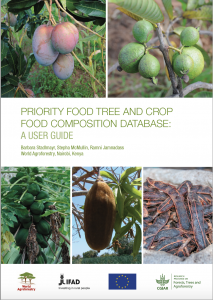Article originally published at World Agroforestry (ICRAF).
Know the nutritional value of selected tree foods in sub-Saharan Africa
A new database of 132 foods from 99 species in Sub-Saharan Africa shows nutritional values for assessing people’s diets and health. The Priority Food Tree and Crop Food Composition Database, developed by the FTA partner World Agroforestry (ICRAF), contains nutritional information of selected tree foods and crops, with a geographical focus on sub-Saharan Africa.
The database comprises 132 foods (out of 99 species) and 30 components. All component values are presented per 100 g edible portion on fresh weight basis. A user guide has also been developed to facilitate the use of the database.

The diversity of exotic and indigenous species included in the database highlights the relevance of agricultural biodiversity, which can support more nutritious diets.
Tree foods are nutritious edible foods from trees and shrubs, including fruits, vegetables, seeds, nuts and edible oils. These tree products can complement and diversify staple-based diets, helping to improve diet quality and health.
However, there remains a challenge with the availability and quality of data on nutrient content for indigenous species, in particular, which have received little attention from researchers despite their potential for providing food and nutrition security.
Without this information, nutritionally valuable foods could be overlooked in agricultural and nutritional development planning, projects and policies.
In addition to actual food composition values, the database includes scores for all foods — ‘high source’, ‘source’, ‘present but low source’ or ‘not a source’ — of selected micronutrients: iron, vitamin A, folate and vitamin C.
Searches can be done by food name, scientific name and by food group.
‘Food composition data play a key role in linking agriculture to nutrition. Knowing what people eat and which nutrients the foods contain is key in assessing and improving diet quality and health,’ said Barbara Stadlmayr, co-author of the guide.
It is equally important for agriculture, including domestication and breeding programs, to select not only high-yielding but also highly nutritious species.
The database was created during development of the Food Tree and Crop Portfolios by World Agroforestry. The portfolios are combinations of indigenous, underutilized and exotic food tree and crop species that can provide year-round nutritious foods to address harvest and nutrient gaps in local diets. The European Commission and the International Fund for Agricultural Development supported the development of the portfolios and the database.
In order to address certain ‘nutrient gaps’ found in diets at any particular site, food tree species and others were mapped with food composition data. For the portfolios, the micronutrients iron, vitamin A (expressed as retinol equivalent), folate and vitamin C were selected. These nutrients were picked because of their public health concerns (iron, vitamin A, folate), their supportive functions (vitamin C supports the uptake of iron from plant foods) and their natural high quantity in tree foods (iron, vitamin A, folate, vitamin C).
However, the tree foods and other foods included in the portfolios contain several additional key vitamins, minerals and macronutrients that are of importance to the human body. To sustain all body functions and hence a healthy life, a well-balanced diet containing a variety of safe and nutritious foods is important.
Therefore, the collection of food composition data has been extended to proximates, vitamins and minerals.
The database presents the backbone of the portfolios but can also be used for dietary assessments, development of education and training materials, selection of nutritious species for agricultural domestication and breeding programs and much more. It is a work in progress and will be updated regularly.
Download the guide
Stadlmayr B, McMullin S, Jamnadass R. 2019. Priority food tree and crop food composition database: a user guide. Version 1. Nairobi, Kenya: World Agroforestry (ICRAF).
This research was conducted by World Agroforestry (ICRAF) as part of the CGIAR Research Program on Forests, Trees and Agroforestry, the world’s largest research-for-development program to enhance the role of forests, trees and agroforestry in sustainable development and food security and to address climate change. The Center for International Forestry Research (CIFOR) leads the Research Program in partnership with Bioversity International, Centro Agronómico Tropical de Investigación y Enseñanza (CATIE), Centre de Coopération Internationale en Recherche Agronomique pour le Développement (CIRAD), International Bamboo and Rattan Organisation (INBAR), ICRAF and Tropenbos International (TBI). The work of the Research Program is supported by the CGIAR Trust Fund.











